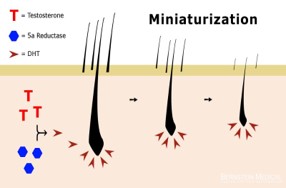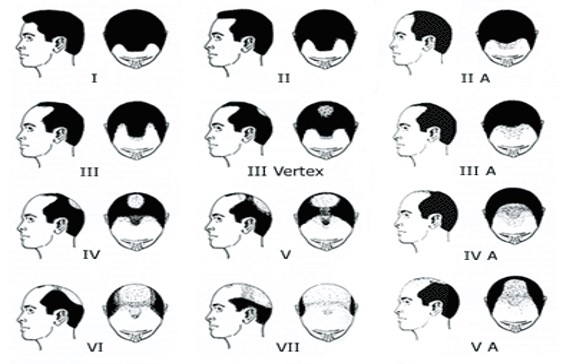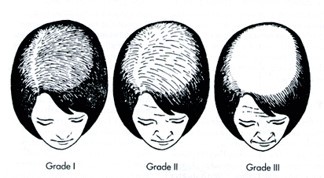Affecting 70% of all men and 50% of women in their lifetime, hereditary baldness is a common condition seen worldwide. This is commonly referred to as Patterned hair loss, Common baldness of men and women or androgenetic alopecia.
Hereditary Baldness: The Root of the Problem
The cause of baldness is well known. Research has confirmed that hair loss is inherited like the color of the eyes. The gene can be inherited from the mother or father’s side. The hair follicles are genetically coded and consist of receptors that are sensitive to the hormone dihydrotestosterone (DHT).
The hair follicles on the top of the head possesses these receptors. Under the influence of this hormone DHT, these hair follicles which are genetically “programmed”, begin shrinking in adulthood. When this occurs, the hair follicles become finer and smaller, lighter in color, shorter and less deeply rooted than their predecessors – gradually – hence they are called miniaturized hairs. Over time, they stop growing to result in baldness.


The severity increases with age progressively and relentlessly. In most cases, this “thinning hair” will progress to “baldness” when the shrinking follicles finally stop producing hair. It is important to understand that DHT which causes its problem, is synthesized in scalp itself- and does not come from blood.
Hamilton classification for men
For men (Male pattern hair loss-MPHL), permanent baldness generally follows a specific pattern which starts either in temporal areas (sides of head) or vertex (top of head). As can be seen in the figure below, there are different stages of hair loss that a man presents, and his baldness progresses through.

In general, those who begin losing hair in the second decade are those in whom the hair loss will be the most severe. In some men, initial male-pattern hair loss may be delayed until the late third to fourth decade. It is generally recognized that men in their 20’s have a 20 percent incidence of MPHL, in their 30’s a 30 percent incidence of MPHL, in their 40’s a 40 percent incidence of MPHL, etc.
Using these numbers one can see that a male in his 90’s has a 90 percent chance of having some degree of MPHL.
However, all patients do not fit in to this pattern- some have diffuse thinning.
Ludwig classification for women
Just as in men, women can also present with patterned hair loss. Noticed later in life, female pattern hair loss (FPHL) differs from male pattern hair loss (MPHL) in the many ways. More commonly seen at times of hormonal change, i.e., use of birth control pills, after childbirth, around the time of menopause, and after menopause. Recession at the temples is less likely than in men and women tend to maintain the position of their hairlines.
Like in men, the entire top of the scalp is the area of risk. In women there is generally a diffuse thinning throughout the area as opposed to thinning in the crown of men. However, Women rarely experience total loss of hair in an area if the loss is due to FPHL. Androgens are responsible for hair loss in women by the same mechanisms they cause hair loss in men. Women do produce small amounts of androgens by way of the ovaries and adrenal glands.
Also, prehormones are produced by the ovaries that are converted to androgens outside of the ovaries or adrenal glands.

It is important to note that even, in the most extensive cases, a horseshoe-shaped fringe of hair remains in the back of the scalp. This hair-bearing fringe is insensitive to the balding process and usually will last a lifetime. Because hair is genetically programmed in the hair follicle, the hair in this area serves as the basis for hair transplantation. These hairs, when transplanted into thinning or balding areas, will take root and grow, and continue to grow for the rest of a person’s life.
Please note:
Once hairs have fully miniaturized, and are lost, there is no treatment to bring them back. Only hair transplantation is the treatment.
Hairs in early thinning can be stimulated and strengthened by drugs, PRP and laser- so medical therapy is important to prevent future hair loss.



